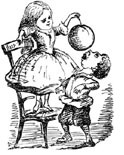
Antidote to the Ideologization of Children’s Literature
REVERT'S ROSTRUM
In the summer of 1847, Danish author Hans Christian Andersen — famous across Europe for his travelogues and literary fairy tales such as “The Little Mermaid” and “The Emperor’s New Clothes” — visited England for the first time. His quasi-promotional tour was welcomed with great fanfare. During a party hosted by the countess of Blessington, Andersen was introduced to Charles Dickens, celebrated in his own right for The Pickwick Papers and A Christmas Carol. Andersen wrote of the meeting in his diary: “We were on the veranda, and I was so happy to see and speak to England’s now-living writer whom I do love the most.”
Andersen and Dickens — both Protestants of an unconventional variety — respected each other’s work, and a friendship developed. Ten years later, Andersen returned to England, primarily to see Dickens. “My visit is intended for you alone…. Above all, always leave me a small corner in your heart,” Andersen wrote to the Englishman in saccharine language that was a harbinger of what was soon to come. A brief visit to Dickens’s country home in Kent extended to five weeks, during which time Andersen gradually tried the patience of the Dickens family.
Exhibiting behavior reminiscent of an eccentric character in a children’s book, Andersen complained of the cold and that no one was available to shave him in the morning. He displayed dramatic mood swings, at one point lying down on the lawn and weeping after learning of a bad review. Dickens’s daughter Kate referred to the writer as “a bony bore.” Eventually, Dickens requested he leave. After Andersen’s departure, Dickens gradually ceased all correspondence with the Dane, much to the latter’s dismay and bewilderment. Scholars suspect that Dickens modeled the physical appearance and mannerisms of Uriah Heep, a sycophantic antagonist in David Copperfield, after Andersen.
It’s a curiosity that a man beloved for penning children’s literature — not only classics that have been adapted into Hollywood blockbusters, but timeless (if sobering and melancholy) tales such as “The Steadfast Tin Soldier” and “The Little Match Girl” — would be so odd that even children found him unrelatable. Yet, far more befuddling is modern commentary on Andersen’s oeuvre; today’s critics accuse the Dane of sins he could hardly have understood. For instance, British actress Keira Knightley once declared that she would not permit her daughter to watch Disney’s The Little Mermaid, not because of how far the film version diverges from the original but because it teaches girls that it’s acceptable to “give your voice up for a man.” Actress and comedienne Mindy Kaling in a similar vein declared, “The ultimate dream in life is not to become married to a white prince.”
You May Also Enjoy
Today sensitivity is a virtue, stimuli are irresistible, environment is determinative, and we prefer our chicken frozen and wrapped in plastic.
Willa Cather, in Death Comes for the Archbishop, offers a clear literary portrait of a man who sees the divine in the ordinary.
St. Francis was that rarest of revolutionaries: one impelled by love rather than by hatred veneered with the catchwords of brotherhood.

